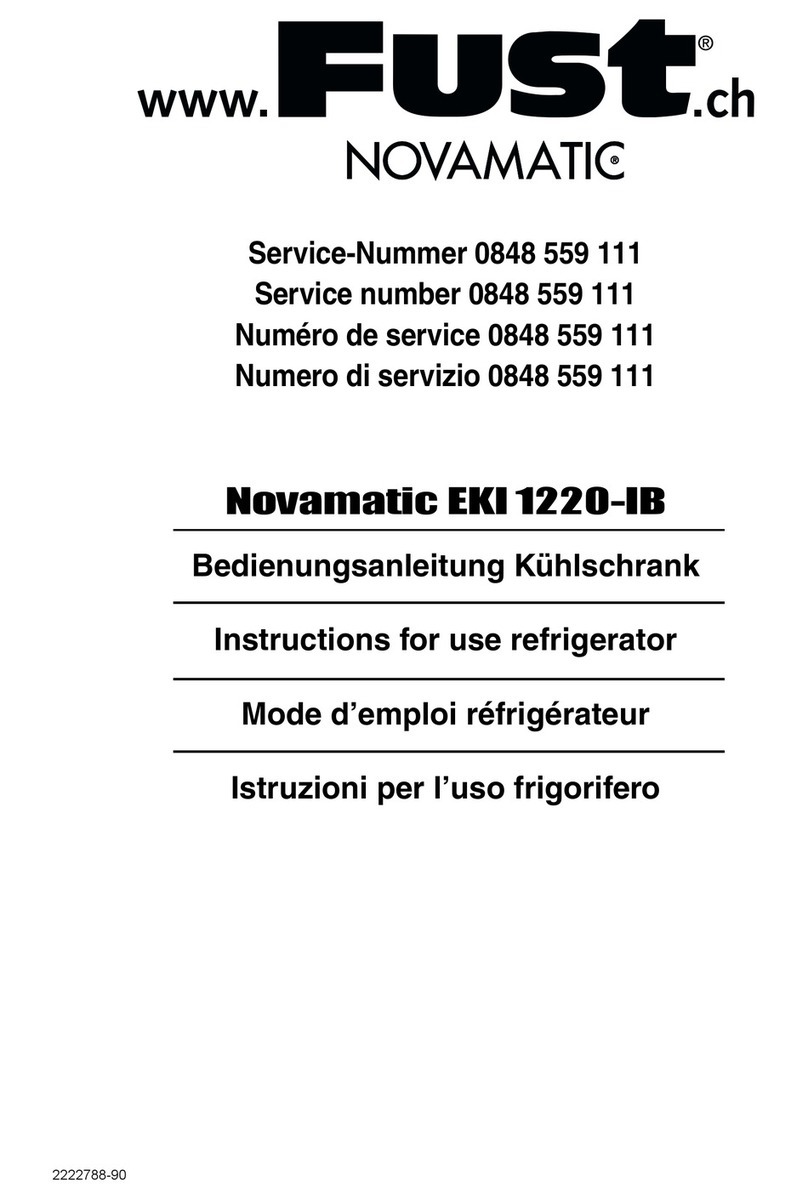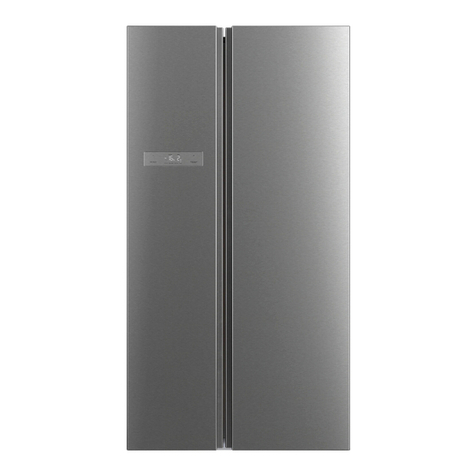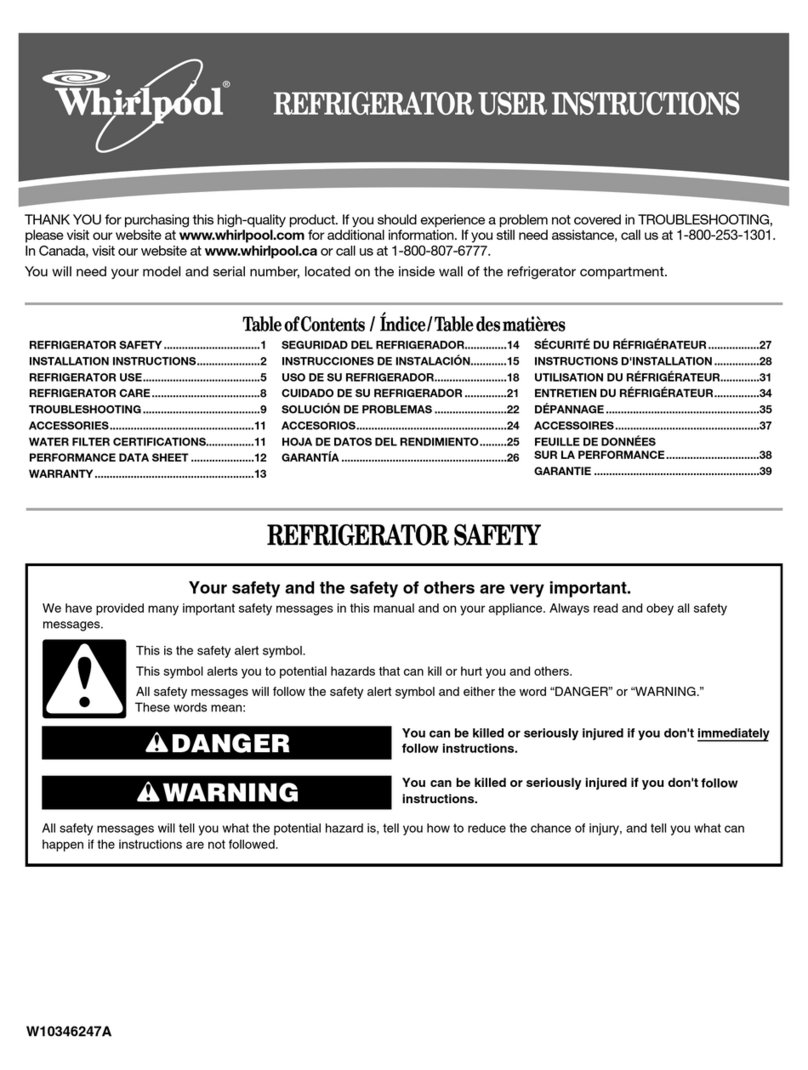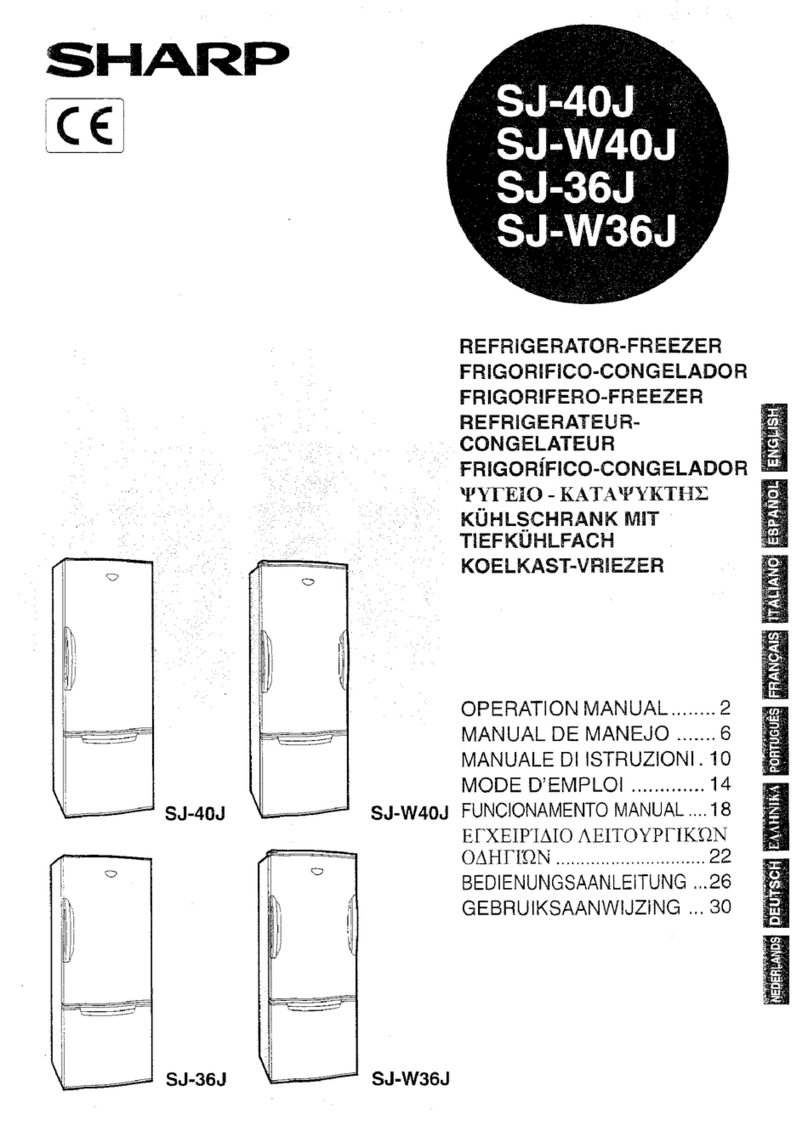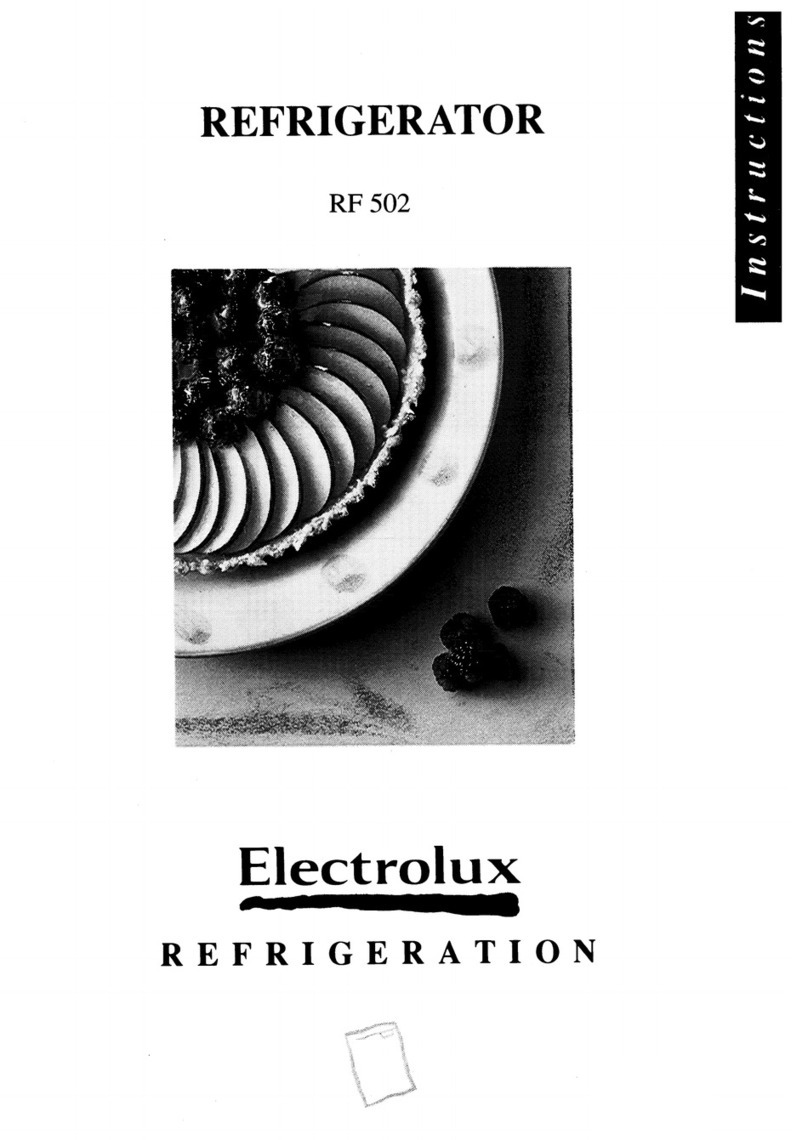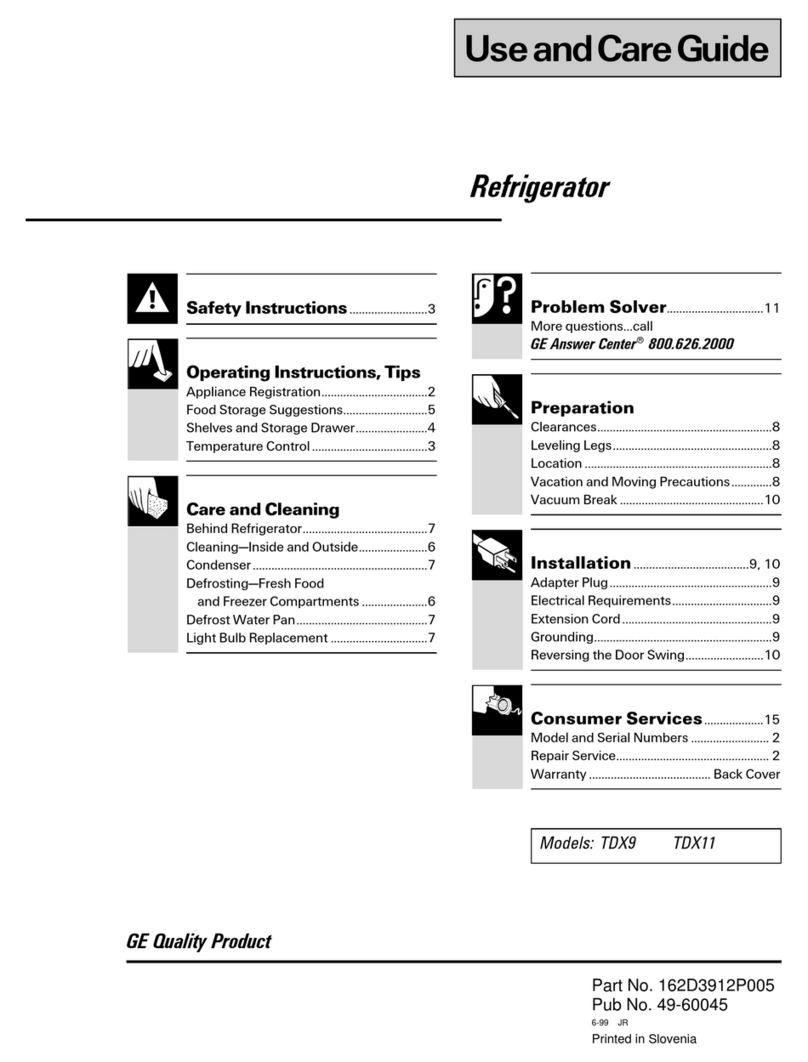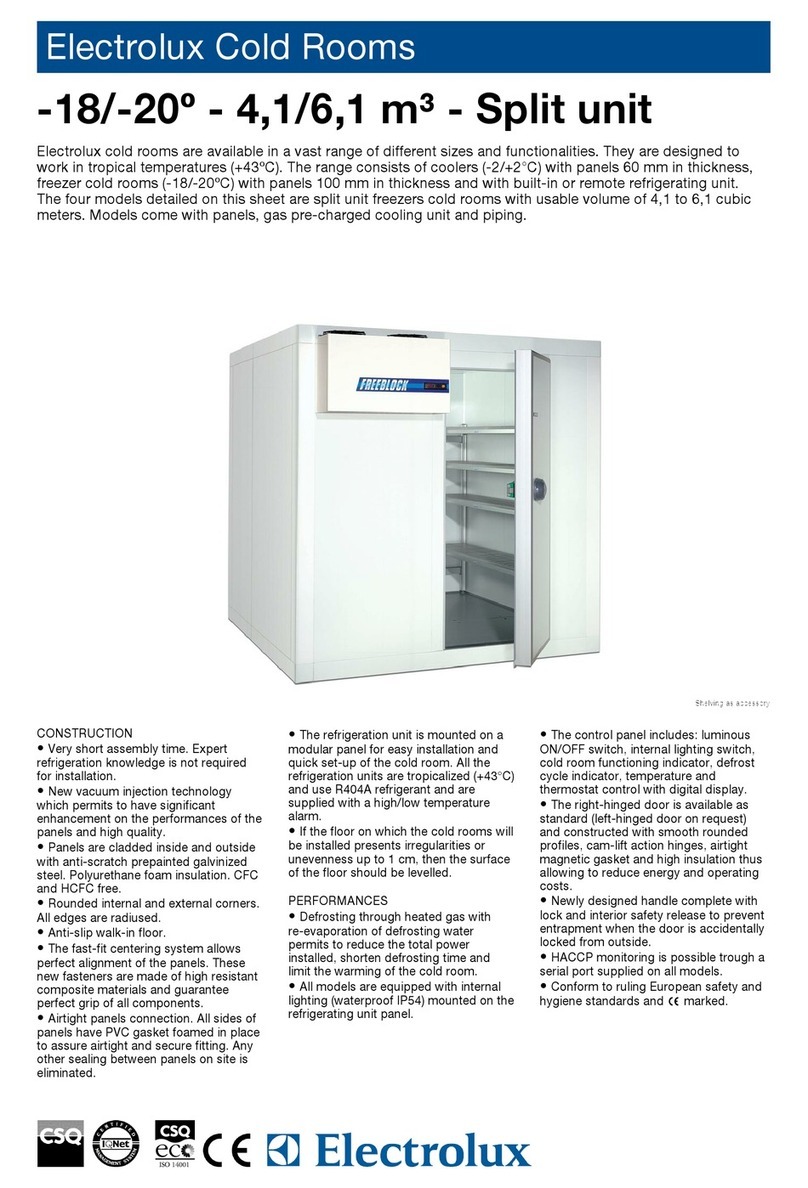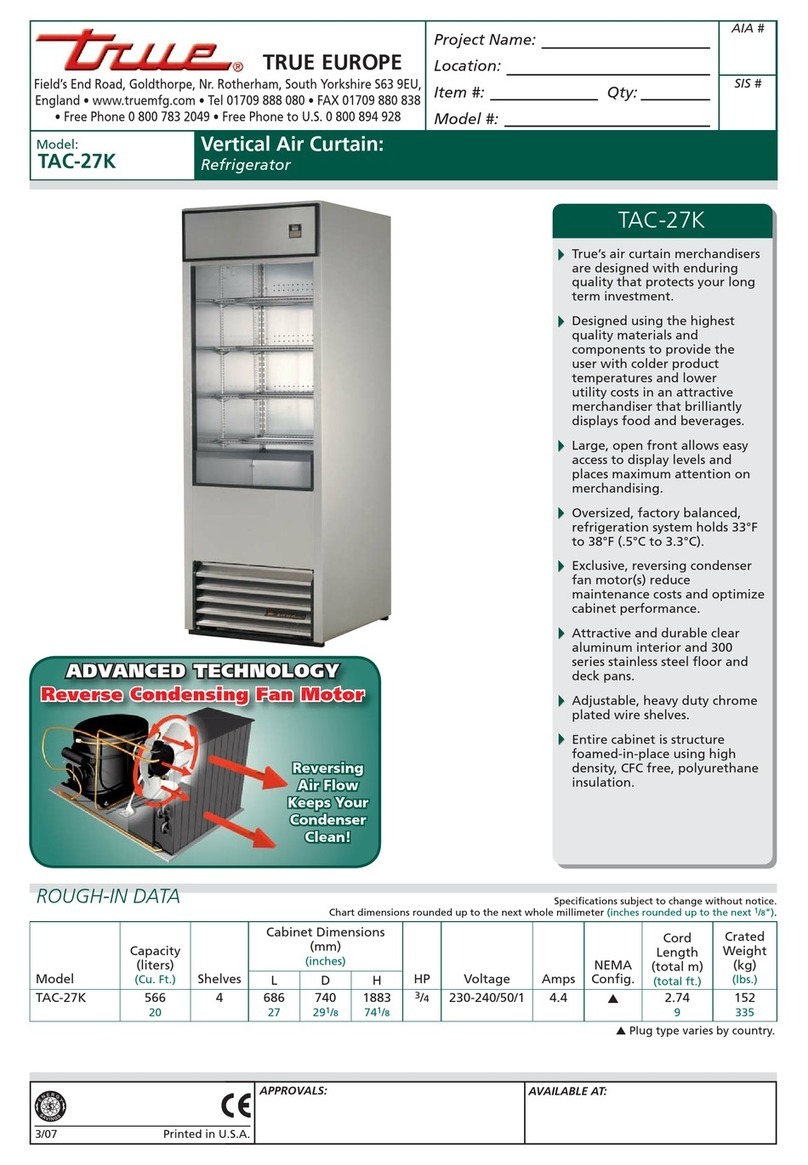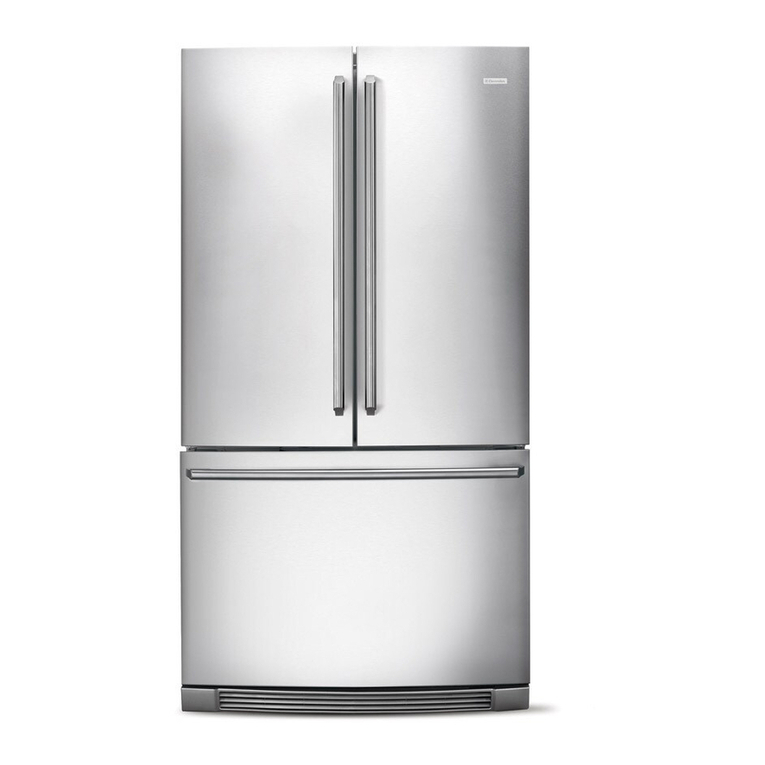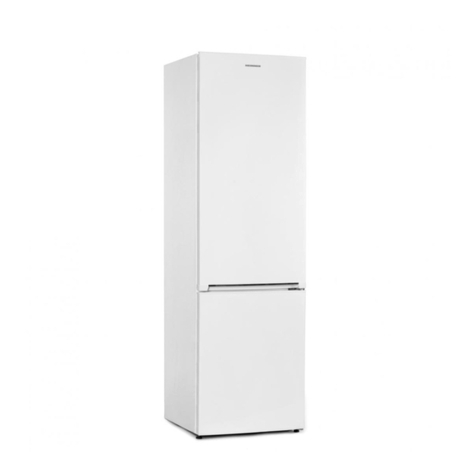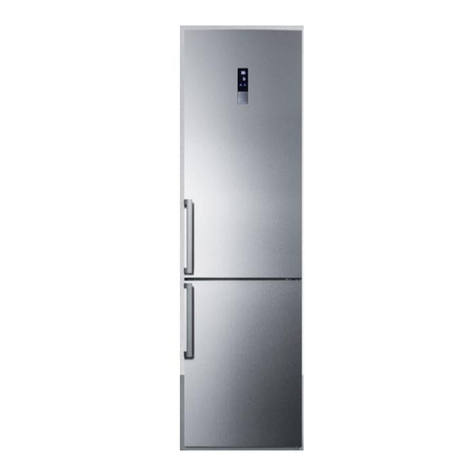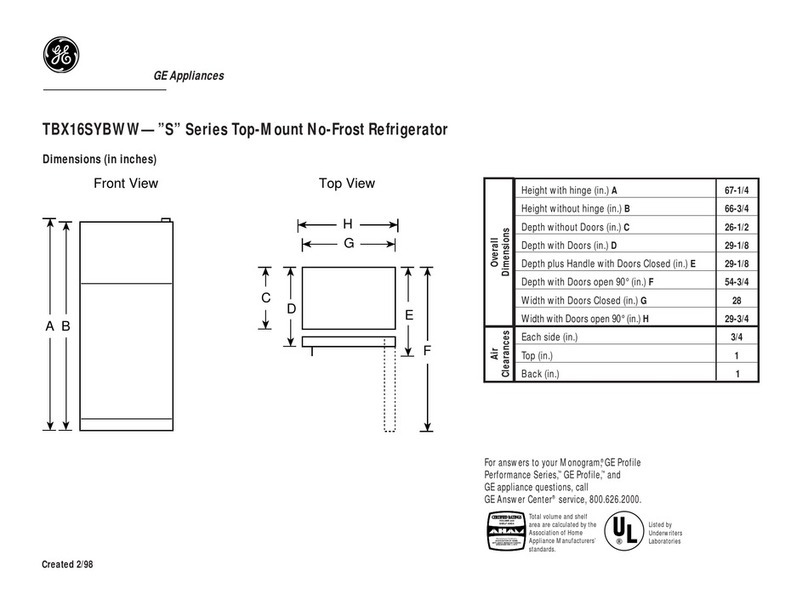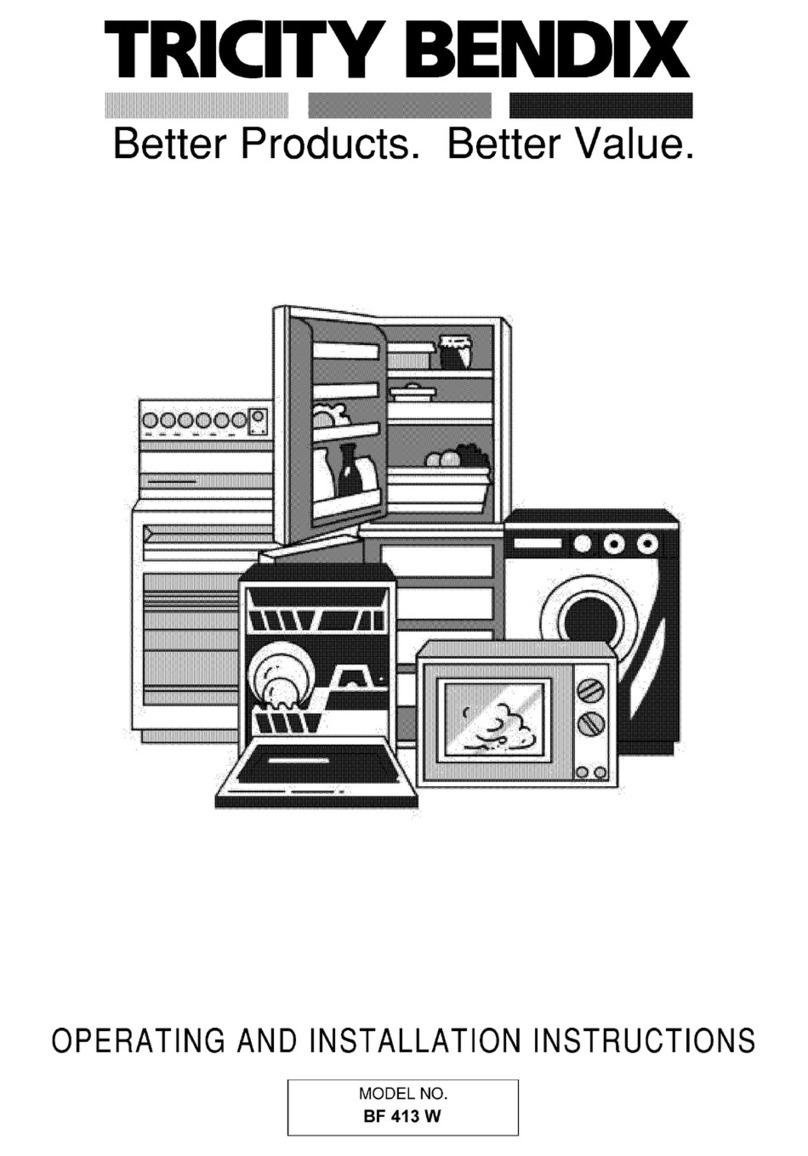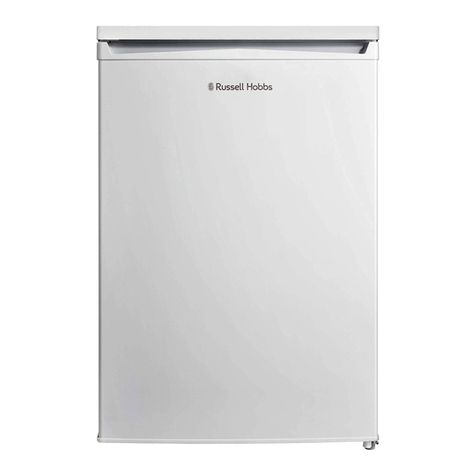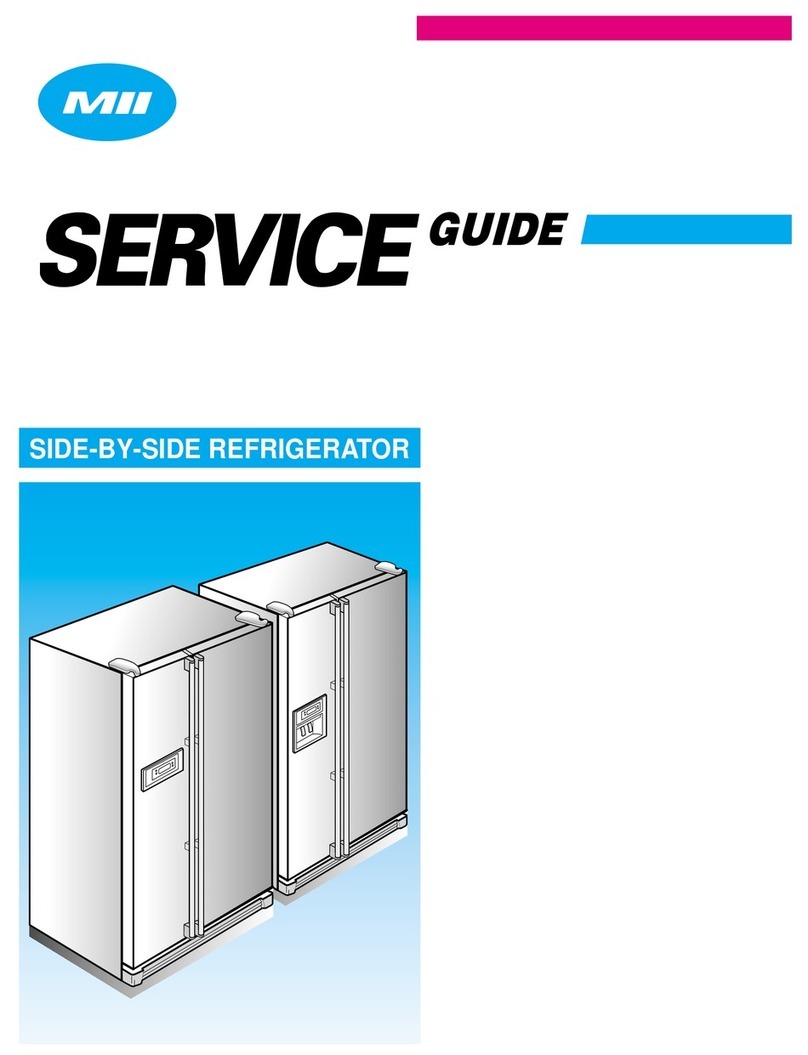Novamatic EKI-1221-IB User manual

www. .ch
EKI1221-IB
User manual
Notice d'utilisation
Benutzerinformation
Istruzioni per l’uso
Fridge
Réfrigérateur
Kühlschrank
Frigorifero
0848 559 111 www.fust.ch

Contents
Safety information 2
Control panel 4
First use 5
Daily use 5
Helpful hints and tips 6
Care and cleaning 7
What to do if… 8
Technical data 11
Installation 11
Environmental concerns 11
Subject to change without notice
Safety information
In the interest of your safety and to ensure
the correct use, before installing and first us-
ing the appliance, read this user manual
carefully, including its hints and warnings. To
avoid unnecessary mistakes and accidents,
it is important to ensure that all people using
the appliance are thoroughly familiar with its
operation and safety features. Save these in-
structions and make sure that they remain
with the appliance if it is moved or sold, so
that everyone using it through its life will be
properly informed on appliance use and safe-
ty.
For the safety of life and property keep the
precautions of these user's instructions as
the manufacturer is not responsible for dam-
ages caused by omission.
Children and vulnerable people safety
• This appliance is not intended for use by
persons (including children) with reduced
physical, sensory or mental capabilities, or
lack of experience and knowledge, unless
they have been given supervision or in-
struction concerning use of the appliance
by a person responsible for their safety.
Children should be supervised to ensure
that they do not play with the appliance.
• Keep all packaging well away from chil-
dren. There is risk of suffocation.
• If you are discarding the appliance pull the
plug out of the socket, cut the connection
cable (as close to the appliance as you
can) and remove the door to prevent play-
ing children to suffer electric shock or to
close themselves into it.
• If this appliance featuring magnetic door
seals is to replace an older appliance hav-
ing a spring lock (latch) on the door or lid,
be sure to make that spring lock unusable
before you discard the old appliance. This
will prevent it from becoming a death trap
for a child.
General safety
Caution! Keep ventilation openings
clear of obstruction.
• The appliance is intended for keeping
foodstuff and/or beverages in a normal
household as explained in this instruction
booklet.
• Do not use a mechanical device or any ar-
tificial means to speed up the thawing
process.
• Do not use other electrical appliances
(such as ice cream makers) inside of re-
frigerating appliances, unless they are ap-
proved for this purpose by the manufac-
turer.
• Do not damage the refrigerant circuit.
• The refrigerant isobutane (R600a) is con-
tained within the refrigerant circuit of the
appliance, a natural gas with a high level of
environmental compatibility, which is nev-
ertheless flammable.
During transportation and installation of
the appliance, be certain that none of the
components of the refrigerant circuit be-
come damaged.
If the refrigerant circuit should become
damaged:
– avoid open flames and sources of igni-
tion
– thoroughly ventilate the room in which
the appliance is situated
2

• It is dangerous to alter the specifications or
modify this product in any way. Any dam-
age to the cord may cause a short-circuit,
fire and/or electric shock.
Warning! Any electrical component
(power cord, plug, compressor) must be
replaced by a certified service agent or
qualified service personnel.
1. Power cord must not be lengthened.
2. Make sure that the power plug is not
squashed or damaged by the back of
the appliance. A squashed or dam-
aged power plug may overheat and
cause a fire.
3. Make sure that you can come to the
mains plug of the appliance.
4. Do not pull the mains cable.
5. If the power plug socket is loose, do
not insert the power plug. There is a
risk of electric shock or fire.
6. You must not operate the appliance
without the lamp cover
1)
of interior
lighting.
• This appliance is heavy. Care should be
taken when moving it.
• Do not remove nor touch items from the
freezer compartment if your hands are
damp/wet, as this could cause skin abra-
sions or frost/freezer burns.
• Avoid prolonged exposure of the appli-
ance to direct sunlight.
Daily Use
• Do not put hot pot on the plastic parts in
the appliance.
• Do not store flammable gas and liquid in
the appliance, because they may explode.
• Do not place food products directly
against the air outlet on the rear wall.
2)
• Frozen food must not be re-frozen once it
has been thawed out.
• Store pre-packed frozen food in accord-
ance with the frozen food manufacturer's
instructions.
• Appliance's manufacturers storage rec-
ommendations should be strictly adhered
to. Refer to relevant instructions.
• Do not place carbonated or fizzy drinks in
the freezer compartment as it creates
pressure on the container, which may
cause it to explode, resulting in damage to
the appliance.
• Ice lollies can cause frost burns if con-
sumed straight from the appliance.
Care and cleaning
• Before maintenance, switch off the appli-
ance and disconnect the mains plug from
the mains socket. If you cannot come to
the mains socket, interrupt the power sup-
ply.
• Do not clean the appliance with metal ob-
jects.
• Do not use sharp objects to remove frost
from the appliance. Use a plastic scraper.
• Regularly examine the drain in the refriger-
ator for defrosted water. If necessary,
clean the drain. If the drain is blocked, wa-
ter will collect in the bottom of the appli-
ance.
Installation
Important! For electrical connection
carefully follow the instructions given in
specific paragraphs.
• Unpack the appliance and check if there
are damages on it. Do not connect the ap-
pliance if it is damaged. Report possible
damages immediately to the place you
bought it. In that case retain packing.
• It is advisable to wait at least four hours
before connecting the appliance to allow
the oil to flow back in the compressor.
• Adequate air circulation should be around
the appliance, lacking this leads to over-
heating. To achieve sufficient ventilation
follow the instructions relevant to installa-
tion.
• Wherever possible the back of the product
should be against a wall to avoid touching
or catching warm parts (compressor, con-
denser) to prevent possible burn.
• The appliance must not be located close
to radiators or cookers.
• Make sure that the mains plug is accessi-
ble after the installation of the appliance.
•Connect to potable water supply only.
3)
1) If the lamp cover is foreseen
2) If the appliance is Frost Free
3) If a water connection is foreseen
3

Service
• Any electrical work required to do the serv-
icing of the appliance should be carried out
by a qualified electrician or competent per-
son.
• This product must be serviced by an au-
thorized Service Centre, and only genuine
spare parts must be used.
Environment Protection
This appliance does not contain gasses
which could damage the ozone layer, in
either its refrigerant circuit or insulation
materials. The appliance shall not be dis-
carded together with the urban refuse
and rubbish. The insulation foam con-
tains flammable gases: the appliance
shall be disposed according to the ap-
plicable regulations to obtain from your
local authorities. Avoid damaging the
cooling unit, especially at the rear near
the heat exchanger. The materials used
on this appliance marked by the symbol
are recyclable.
Control panel
Fridge Control panel
1 2 3 4 15 6 7 8 9
1. Pilot light
2. ON/OFF switch
3. Temperature regulator (warmest)
4. Temperature indicator
5. Temperature regulator (coldest)
6. Action Freeze light
7. Action Freeze switch
8. Action Cool light
9. Action Cool switch
Switching on
Insert the plug into the wall socket.
Press the ON/OFF switch .
The Pilot Light will light up.
Important! At start-up the displayed
temperature don't correspond with the set
temperature until stabilised (within 24 hours).
Switching off
Press ON/OFF switch until a countdown
from -3 -2 -1 is completed.
The temperature indicator switches off. The
Pilot light switches off.
Temperature regulation
The temperature can be adjusted between
+2°C and +8°C.
By pressing the Temperature regulators, the
current temperature setting flashes on the
Temperature indicator. It is possible to mod-
ify the setting temperature only with flashed
indicator. To set a warmer temperature,
press warmest Temperature regulator. To
set a colder temperature, press coldest Tem-
perature regulator. The Temperature indica-
tor displays the newly selected temperature
for a few seconds and then shows again the
inside compartment temperature.
The newly selected-temperature must be
reached after 24 hours.
Temperature indicator
During normal functioning the Temperature
indicator shows the temperature inside the
fridge.
Important! Difference between the
temperature displayed and temperature
setting is normal. Especially when:
• a new setting has recently been selected.
• the door has been left open for a long time.
• warm food has been placed in the com-
partment.
4

Action Freeze function
You can activate the Action Freeze function
by pressing the Action Freeze switch.
The Action Freeze light will light up.
This function stops automatically after 48
hours.
It is possible to deactivate the function at any
time by pressingAction Freeze switch.
The Action Freeze light will switch off.
Action Cool function
The maximum performance is obtained by
setting the Action Coolfunction. It’s recom-
mended when loading large quantities of
food.
You can activate the Action Cool function by
pressing the Action Cool switch.
The Action Cool light will light up.
Important! The internal temperature goes
down to +2°C.
After about 6 hours the Action Cool function
switches off automatically.
First use
Cleaning the interior
Before using the appliance for the first time,
wash the interior and all internal accessories
with lukewarm water and some neutral soap
so as to remove the typical smell of a brand-
new product, then dry thoroughly.
Important! Do not use detergents or abra-
sive powders, as these will damage the fin-
ish.
Daily use
Freezing fresh food
The freezer compartment is suitable for
freezing fresh food and storing frozen and
deep-frozen food for a long time.
To freeze fresh food activate the Action
Freeze function at least 24 hours before plac-
ing the food to be frozen in the freezer com-
partment.
The maximum amount of food that can be
frozen in 24 hours is specified on the rating
plate , a label located on the inside of the
appliance.
The freezing process lasts 24 hours: during
this period do not add other food to be fro-
zen.
After 24 hours, when the freezing process is
completed, return to the required tempera-
ture (see "Temperature regulation").
Storage of frozen food
When first starting-up or after a period out of
use, before putting the products in the com-
partment let the appliance run at least 2
hours on the higher settings.
Important! In the event of accidental
defrosting, for example due to a power
failure, if the power has been off for longer
than the value shown in the technical
characteristics chart under "rising time", the
defrosted food must be consumed quickly or
cooked immediately and then re-frozen (after
cooling).
Freezing Calendar
The symbols show different types of frozen
goods.
The numbers indicate storage times in
months for the appropriate types of frozen
goods. Whether the upper or lower value of
the indicated storage time is valid depends
on the quality of the foods and treating before
freezing.
Thawing
Deep-frozen or frozen food, prior to being
used, can be thawed in the refrigerator com-
partment or at room temperature, depending
on the time available for this operation.
5

Small pieces may even be cooked still frozen,
directly from the freezer: in this case, cooking
will take longer.
Ice-cube production
This appliance is equipped with one or more
trays for the production of ice-cubes. Fill
these trays with water, then put them in the
freezer compartment.
Important! Do not use metallic instruments
to remove the trays from the freezer.
Movable shelves
The walls of the refrigerator are equipped
with a series of runners so that the shelves
can be positioned as desired.
For better use of space, the front half-shelves
can lie over the rear ones.
Positioning the door shelves
To permit storage of food packages of vari-
ous sizes, the door shelves can be placed at
different heights.
To make these adjustments proceed as fol-
lows:
gradually pull the shelf in the direction of the
arrows until it comes free, then reposition as
required.
Helpful hints and tips
Hints for energy saving
• Do not open the door frequently or leave it
open longer than absolutely necessary.
• If the ambient temperature is high and the
Temperature Regulator is set to low tem-
perature and the appliance is fully loaded,
the compressor may run continuously,
causing frost or ice on the evaporator. If
this happens, set the Temperature Regu-
lator toward warmer settings to allow au-
tomatic defrosting and so a saving in elec-
tricity consumption.
Hints for fresh food refrigeration
To obtain the best performance:
• do not store warm food or evaporating liq-
uids in the refrigerator
• do cover or wrap the food, particularly if it
has a strong flavour
• position food so that air can circulate freely
around it
Hints for refrigeration
Useful hints:
Meat (all types) : wrap in polythene bags and
place on the glass shelf above the vegetable
drawer.
For safety, store in this way only one or two
days at the most.
6

Cooked foods, cold dishes, etc..: these
should be covered and may be placed on any
shelf.
Fruit and vegetables: these should be thor-
oughly cleaned and placed in the special
drawer(s) provided.
Butter and cheese: these should be placed
in special airtight containers or wrapped in
aluminium foil or polythene bags to exclude
as much air as possible.
Milk bottles: these should have a cap and
should be stored in the bottle rack on the
door.
Bananas, potatoes, onions and garlic, if not
packed, must not be kept in the refrigerator.
Hints for freezing
To help you make the most of the freezing
process, here are some important hints:
• the maximum quantity of food which can
be frozen in 24 hrs. is shown on the rating
plate;
• the freezing process takes 24 hours. No
further food to be frozen should be added
during this period;
• only freeze top quality, fresh and thorough-
ly cleaned, foodstuffs;
• prepare food in small portions to enable it
to be rapidly and completely frozen and to
make it possible subsequently to thaw only
the quantity required;
• wrap up the food in aluminium foil or pol-
ythene and make sure that the packages
are airtight;
• do not allow fresh, unfrozen food to touch
food which is already frozen, thus avoiding
a rise in temperature of the latter;
• lean foods store better and longer than
fatty ones; salt reduces the storage life of
food;
• water ices, if consumed immediately after
removal from the freezer compartment,
can possibly cause the skin to be freeze
burnt;
• it is advisable to show the freezing in date
on each individual pack to enable you to
keep tab of the storage time.
Hints for storage of frozen food
To obtain the best performance from this ap-
pliance, you should:
• make sure that the commercially frozen
foodstuffs were adequately stored by the
retailer;
• be sure that frozen foodstuffs are transfer-
red from the foodstore to the freezer in the
shortest possible time;
• not open the door frequently or leave it
open longer than absolutely necessary.
• Once defrosted, food deteriorates rapidly
and cannot be refrozen.
• Do not exceed the storage period indica-
ted by the food manufacturer.
Care and cleaning
Caution! Unplug the appliance before
carrying out any maintenance operation.
This appliance contains hydrocarbons in
its cooling unit; maintenance and re-
charging must therefore only be carried
out by authorized technicians.
Periodic cleaning
The equipment has to be cleaned regularly:
• clean the inside and accessories with luke-
warm water and some neutral soap.
• regularly check the door seals and wipe
clean to ensure they are clean and free
from debris.
• rinse and dry thoroughly.
Important! Do not pull, move or damage any
pipes and/or cables inside the cabinet.
Never use detergents, abrasive powders,
highly perfumed cleaning products or wax
polishes to clean the interior as this will dam-
age the surface and leave a strong odour.
Clean the condenser (black grill) and the
compressor at the back of the appliance with
a brush or a vacuum cleaner. This operation
will improve the performance of the appli-
ance and save electricity consumption.
Important! Take care of not to damage the
cooling system.
7

Many proprietary kitchen surface cleaners
contain chemicals that can attack/damage
the plastics used in this appliance. For this
reason it is recommended that the outer cas-
ing of this appliance is only cleaned with
warm water with a little washing-up liquid
added.
After cleaning, reconnect the equipment to
the mains supply.
Defrosting of the refrigerator
Frost is automatically eliminated from the
evaporator of the refrigerator compartment
every time the motor compressor stops, dur-
ing normal use. The defrost water drains out
through a trough into a special container at
the back of the appliance, over the motor
compressor, where it evaporates.
It is important to periodically clean the defrost
water drain hole in the middle of the refriger-
ator compartment channel to prevent the
water overflowing and dripping onto the food
inside. Use the special cleaner provided,
which you will find already inserted into the
drain hole.
Defrosting the freezer
A certain amount of frost will always form
around the top compartment.
Important! Defrost the freezer when the
frost layer reaches a thickness of about 3-5
mm.
To remove the frost, do these steps:
1. Switch off the appliance.
2. Remove any stored food, wrap it in sev-
eral layers of newspaper and put it in a
cool place.
3. Open the door.
4. When defrosting is completed, dry the in-
terior thoroughly.
5. Switch on the appliance.
6. Set the temperature regulator to obtain
the maximum coldness and run the ap-
pliance for two or three hours using this
setting.
7. Reload the previously removed food into
the compartment.
Warning! Never use sharp metal tools
to scrape off frost from the evaporator
as you could damage it. Do not use a
mechanical device or any artificial means
to speed up the thawing process other
than those recommended by the
manufacturer. A temperature rise of the
frozen food packs, during defrosting,
may shorten their safe storage life.
Periods of non-operation
When the appliance is not in use for long pe-
riods, take the following precautions:
•disconnect the appliance from elec-
tricity supply
• remove all food
•defrost
4)
and clean the appliance and all
accessories
• leave the door/doors ajar to prevent un-
pleasant smells.
If the cabinet will be kept on, ask somebody
to check it once in a while to prevent the food
inside from spoiling in case of a power failure.
What to do if…
Warning! Before troubleshooting,
disconnect the mains plug from the
mains socket.
Only a qualified electrician or competent
person must do the troubleshooting that
is not in this manual.
4) If foreseen.
8

Important! There are some sounds during
normal use (compressor, refrigerant
circulation).
Problem Possible cause Solution
The appliance is noisy The appliance is not supported
properly Check if the appliance stands sta-
ble (all the four feet should be on
the floor)
The appliance does not
operate. The lamp does
not operate.
The appliance is switched off. Switch on the appliance.
The mains plug is not connected
to the mains socket correctly. Connect the mains plug to the
mains socket correctly.
The appliance has no power.
There is no voltage in the mains
socket.
Connect a different electrical appli-
ance to the mains socket.
Contact a qualified electrician.
The lamp does not work. The lamp is defective. Refer to "Replacing the lamp".
The compressor operates
continually.
The temperature is not set cor-
rectly. Set a higher temperature.
The door is not closed correctly. Refer to "Closing the door".
The door has been opened too
frequently. Do not keep the door open longer
than necessary.
The product temperature is too
high. Let the product temperature de-
crease to room temperature before
storage.
The room temperature is too
high. Decrease the room temperature.
The compressor does not
start immediately after
pressing the Action
Freezeor Action Cool-
switch, or after changing
the temperature.
This is normal, no error has oc-
curred. The compressor starts after a pe-
riod of time.
Water flows on the rear
plate of the refrigerator.
During the automatic defrosting
process, frost defrosts on the rear
plate.
This is correct.
Water flows into the re-
frigerator.
The water outlet is clogged. Clean the water outlet.
Products prevent that water flows
into the water collector. Make sure that products do not
touch the rear plate.
Temperature cannot be
set .
Action Freeze or Action Cool
functions switched on. Switch off Action Freeze or Action
Cool manually, or wait to set the
temperature until the function has
reset automatically. Refer to "Ac-
tion Freeze or Action Cool func-
tion"..
The temperature in the
appliance is too low/high.
The temperature regulator is not
set correctly. Set a higher/lower temperature.
The door is not closed correctly. Refer to "Closing the door".
9

Problem Possible cause Solution
The product temperature is too
high. Let the product temperature de-
crease to room temperature before
storage.
Many products are stored at the
same time. Store less products at the same
time.
The temperature in the re-
frigerator is too high.
There is no cold air circulation in
the appliance. Make sure that there is cold air cir-
culation in the appliance.
The temperature in the
freezer is too high.
Products are too near to each
other. Store products so that there is cold
air circulation.
There is too much frost. Food is not wrapped correctly. Wrap the food correctly.
The door is not closed correctly. Refer to "Closing the door".
The temperature regulator is not
set correctly. Set a higher temperature.
Replacing the lamp
1. Disconnect the mains plug from the
mains socket.
2. Press on the rear hook and at the same
time slide the lamp cover in the direction
of the arrow.
3. Replace the lamp with one of the same
power (the maximum power is shown on
the light lamp cover)
4. Install the lamp cover by sliding it into its
original position.
5. Connect the mains plug to the mains
socket.
6. Open the door. Make sure that the lamp
comes on.
Closing the door
1. Clean the door gaskets.
2. If necessary, adjust the door. Refer to "In-
stallation".
3. If necessary, replace the defective door
gaskets. Contact the Service Force Cen-
ter.
10

Technical data
Dimension of the recess
Height 1225 mm
Width 560 mm
Depth 550 mm
Rising Time 12 h
The technical information are situated in the
rating plate on the internal left side of the ap-
pliance and in the energy label.
Installation
Read the "Safety Information" carefully
for your safety and correct operation of
the appliance before installing the
appliance.
Positioning
Install this appliance at a location where the
ambient temperature corresponds to the cli-
mate class indicated on the rating plate of the
appliance:
Climate
class
Ambient temperature
SN +10°C to + 32°C
N+16°C to + 32°C
ST +16°C to + 38°C
T+16°C to + 43°C
Electrical connection
Before plugging in, ensure that the voltage
and frequency shown on the rating plate cor-
respond to your domestic power supply.
The appliance must be earthed. The power
supply cable plug is provided with a contact
for this purpose. If the domestic power sup-
ply socket is not earthed, connect the appli-
ance to a separate earth in compliance with
current regulations, consulting a qualified
electrician.
The manufacturer declines all responsibility if
the above safety precautions are not ob-
served.
This appliance complies with the E.E.C. Di-
rectives.
Ventilation requirements
The airflow behind the appliance must be
sufficient.
min.
200 cm2
min.
200 cm2
Environmental concerns
The symbol on the product or on its
packaging indicates that this product may
not be treated as household waste. Instead
it should be taken to the appropriate
collection point for the recycling of electrical
and electronic equipment. By ensuring this
product is disposed of correctly, you will help
prevent potential negative consequences for
the environment and human health, which
could otherwise be caused by inappropriate
11

waste handling of this product. For more
detailed information about recycling of this
product, please contact your local council,
your household waste disposal service or the
shop where you purchased the product.
12

Sommaire
Consignes de sécurité 13
Bandeau de commande 15
Première utilisation 16
Utilisation quotidienne 16
Conseils utiles 18
Entretien et nettoyage 19
En cas d'anomalie de fonctionnement 20
Caractéristiques techniques 23
Installation 23
En matière de sauvegarde de
l'environnement 23
Sous réserve de modifications
Consignes de sécurité
Pour votre sécurité et garantir une utilisation
correcte de l'appareil, lisez attentivement
cette notice, y compris les conseils et aver-
tissements, avant d'installer et d'utiliser l'ap-
pareil pour la première fois. Pour éviter toute
erreur ou accident, veillez à ce que toute per-
sonne qui utilise l'appareil connaisse bien
son fonctionnement et ses fonctions de sé-
curité. Conservez cette notice avec l'appa-
reil. Si l'appareil doit être vendu ou cédé à
une autre personne, veillez à remettre cette
notice au nouveau propriétaire, afin qu'il
puisse se familiariser avec son fonctionne-
ment et sa sécurité.
Pour la sécurité des personnes et des biens,
conservez et respectez les consignes de sé-
curité figurant dans cette notice. Le fabricant
décline toute responsabilité en cas de dom-
mages dus au non-respect de ces instruc-
tions.
Sécurité des enfants et des personnes
vulnérables
• Cet appareil n'est pas destiné à être utilisé
par des enfants ou des personnes dont les
capacités physiques, sensorielles ou men-
tales, ou le manque d'expérience et de
connaissance les empêchent d'utiliser
l'appareil sans risque lorsqu'ils sont sans
surveillance ou en l'absence d'instruction
d'une personne responsable qui puisse
leur assurer une utilisation de l'appareil
sans danger.
Empêchez les enfants de jouer avec l'ap-
pareil.
• Ne laissez pas les emballages à la portée
des enfants. Risque d'asphyxie !
• Si l'appareil doit être mis au rebut, sortez
la fiche de la prise électrique, coupez le
cordon d'alimentation au ras de l'appareil
et démontez la porte pour éviter les risques
d'électrocution et que des enfants ne res-
tent enfermés à l'intérieur.
• Si cet appareil muni de fermetures magné-
tiques est destiné à remplacer un appareil
équipé d'une fermeture à ressort sur la
porte ou le couvercle, veuillez faire en sorte
que la fermeture à ressort devienne inutili-
sable avant d'éliminer le vieil appareil. Ceci
afin d'éviter aux enfants de s'enfermer
dans l'appareil et de mettre ainsi leur vie en
danger.
Sécurité générale
Attention Veillez à ce que les orifices de
ventilation ne soient pas obstrués.
• Cet appareil est destiné uniquement à la
conservation d'aliments et/ou de boissons
dans le cadre d'un usage domestique nor-
mal, tel que celui décrit dans la présente
notice.
• N'utilisez pas de dispositifs mécaniques
ou autres moyens artificiels pour accélérer
le dégivrage de l'appareil.
• N'utilisez pas d'autres appareils électri-
ques (par exemple, sorbetières) à l'inté-
rieur d'appareils réfrigérants sauf s'ils sont
homologués pour cet usage par leur fabri-
cant.
• N'endommagez pas le circuit de refroidis-
sement.
13

• Le circuit de refroidissement de l'appareil
contient de l'isobutane (R600a), un gaz
naturel offrant un haut niveau de compati-
bilité avec l'environnement mais qui est
néanmoins inflammable.
Pendant le transport et l'installation de
l'appareil, assurez-vous qu'aucune pièce
du circuit de refroidissement n'est endom-
magée.
Si tel est le cas :
– évitez les flammes vives et les sources
d'ignition
– aérez soigneusement la pièce où se
trouve l'appareil
• Il est dangereux de modifier les caracté-
ristiques de l'appareil ou l'appareil. Un cor-
don d'alimentation endommagé peut être
la cause de courts-circuits, d'incendies et/
ou de décharges électriques.
Avertissement Les composants élec-
triques (cordon d'alimentation, prise,
compresseur) doivent être remplacés
par un technicien d'entretien agréé ou
par un électricien spécialisé.
1. Le cordon d'alimentation ne doit pas
être rallongé.
2. Assurez-vous que la prise n'est pas
écrasée ou endommagée par l'arrière
de l'appareil. Une prise de courant en-
dommagée peut s'échauffer et provo-
quer un incendie.
3. Assurez-vous de pouvoir accéder à la
prise secteur de l'appareil.
4. Ne tirez pas sur le cordon d'alimenta-
tion.
5. Si la fiche du cordon d'alimentation est
desserrée, ne la branchez pas dans la
prise murale. Risque d'électrocution
ou d'incendie.
6. N'utilisez pas l'appareil si le diffuseur
de l'ampoule d'éclairage n'est pas pré-
sent
5)
pour l'éclairage intérieur.
• Cet appareil est lourd. Faites attention lors
de son déplacement.
• Ne touchez pas les produits congelés sor-
tant du congélateur avec les mains humi-
des car ceci peut provoquer des abrasions
ou des brûlures cutanées.
• Évitez les expositions prolongées de l'ap-
pareil aux rayons solaires.
Utilisation quotidienne
• Ne posez pas d'éléments chauds sur les
parties en plastique de l'appareil.
• Ne stockez pas de gaz ou de liquides in-
flammables dans l'appareil (risque d'ex-
plosion).
• Ne placez pas d'aliments directement
contre la sortie d'air sur la paroi arrière de
l'appareil.
6)
• Un produit décongelé ne doit jamais être
recongelé.
• Conservez les aliments emballés confor-
mément aux instructions de leur fabricant.
• Respectez scrupuleusement les conseils
de conservation donnés par le fabricant de
l'appareil. Consultez les instructions res-
pectives.
• Ne mettez pas de bouteilles ni de boîtes
de boissons gazeuses dans le comparti-
ment congélateur, car la pression se for-
mant à l'intérieur du contenant pourrait le
faire éclater et endommager ainsi l'appa-
reil.
• Ne consommez pas certains produits tels
que les bâtonnets glacés dès leur sortie de
l'appareil, car ils peuvent provoquer des
brûlures.
Entretien et nettoyage
• Avant toute opération d'entretien, mettez
l'appareil hors tension et débranchez-le de
la prise de courant. Si la prise électrique
n'est pas accessible, coupez le courant.
• N'utilisez pas d'objets métalliques pour
nettoyer l'appareil.
• N'utilisez pas d'objet tranchant pour grat-
ter la couche de givre. Utilisez une spatule
en plastique.
• Contrôlez régulièrement l'orifice d'évacua-
tion de l'eau de dégivrage dans le com-
partiment réfrigérateur. Nettoyez-le, si be-
soin. Si l'orifice est bouché, l'eau s'écou-
lera en bas de l'appareil.
Installation
Important Pour le branchement électrique,
respectez scrupuleusement les consignes
données dans cette notice.
5) Si le diffuseur est prévu
6) Si l'appareil est sans givre
14

• Déballez l'appareil et vérifiez qu'il n'est pas
endommagé. Ne branchez pas l'appareil
s'il est endommagé. Signalez immédiate-
ment les dommages constatés à votre
vendeur. Dans un tel cas, conservez l'em-
ballage.
• Nettoyez fréquemment l'intérieur du réfri-
gérateur en utilisant un produit d'entretien
doux sans effet oxydant sur les parties mé-
talliques, puis rincer avec de l'eau addi-
tionnée de jus de citron, de vinaigre blanc
ou avec tout produit désinfectant adapté
au réfrigérateur.
• Veillez à ce que l'air circule librement au-
tour de l'appareil pour éviter qu'il ne sur-
chauffe. Pour assurer une ventilation suffi-
sante, respectez les instructions d'instal-
lation.
• Dans la mesure du possible, placez l'ap-
pareil dos au mur pour éviter tout contact
avec des pièces chaudes (compresseur,
condenseur) et tout risque de brûlure.
• L'appareil ne doit pas être placé à proxi-
mité de radiateurs ou de cuisinières.
• Assurez-vous que la prise principale est
accessible une fois l'appareil installé.
• Branchez à l'alimentation en eau potable
uniquement.
7)
Maintenance
• Les branchements électriques nécessai-
res à l'entretien de l'appareil doivent être
réalisés par un électricien spécialisé ou
une personne compétente.
• Cet appareil ne doit être entretenu et ré-
paré que par un service après-vente
agréé, exclusivement à l'aide de pièces
certifiées Constructeur.
Protection de l'environnement
Le circuit de refroidissement et les ma-
tériaux isolants de cet appareil ne con-
tiennent pas de gaz frigorigène suscep-
tible de nuire à la couche d'ozone. L'ap-
pareil ne doit pas être mis au rebut avec
les ordures ménagères et les déchets
urbains. La mousse isolante contient
des gaz inflammables : l'appareil doit
être mis au rebut conformément aux rè-
glements applicables (informez-vous
auprès des services locaux compé-
tents). Veillez à ne pas détériorer les cir-
cuits frigorifiques, notamment au dos, à
proximité de l'évaporateur. Les maté-
riaux utilisés dans cet appareil identifiés
par le symbole sont recyclables.
Bandeau de commande
Bandeau de commande du compartiment réfrigérateur
1 2 3 4 15 6 7 8 9
1. Voyant
2. Touche ON/OFF
3. Thermostat (plus CHAUD)
4. Indicateur de température
5. Thermostat (plus FROID)
6. Voyant Action Freeze
7. Touche Action Freeze
8. Voyant Action Cool
9. Touche Action Cool
Mise en fonctionnement
Branchez l'appareil à une prise murale.
Appuyez sur la touche ON/OFF.
Le voyant s'allume.
Important Pendant la phase de stabilisation
de 24 heures, après la première mise en
service, il est possible que la température
affichée ne corresponde pas à la
température programmée.
7) Si un branchement sur le réseau d'eau est prévu
15

Mise à l'arrêt
Appuyez sur la touche ON/OFF jusqu'à ce
que le décompte -3 -2 -1 soit terminé.
L'indicateur de température s'éteint. Le voy-
ant correspondant s'éteint.
Réglage de la température
La température peut être réglée de +2°C à
+8°C.
Lorsque vous appuyez sur les boutons de
thermostat, la température réglée clignote
sur l'indicateur de température. Il est pos-
sible de modifier la température uniquement
lorsque le voyant clignote. Pour sélectionner
une température plus élevée, appuyez sur le
bouton de thermostat Plus CHAUD. Pour sé-
lectionner une température plus basse, ap-
puyez sur le bouton de thermostat Plus
FROID. L'indicateur de température affiche
pendant quelques secondes la température
venant d'être sélectionnée, puis de nouveau
la température à l'intérieur du compartiment.
La nouvelle température sélectionnée sera
atteinte après 24 heures.
Indicateur de la température
Pendant le fonctionnement normal, l'affi-
cheur indique la température à l'intérieur du
compartiment réfrigérateur.
Important Une différence entre la
température affichée et la température réglée
est normale. En particulier :
• Lorsqu'un nouveau réglage a été récem-
ment sélectionné.
• Lorsque la porte a été laissée ouverte pen-
dant longtemps.
• Lorsque des aliments chauds ont été pla-
cés dans le compartiment.
Fonction Action Freeze
Pour activer la fonction Action Freeze , ap-
puyez sur la touche Action Freeze.
Le voyant Action Freeze s'allume.
Cette fonction s'arrête automatiquement au
bout de 48 heures.
Il est possible de désactiver cette fonction à
n'importe quel moment en appuyant sur la
touche Action Freeze.
Le voyant Action Freeze s'éteint.
Action Cool fonction
On obtient un rendement optimum en réglant
la fonction Action Cool. Cette fonction sert à
refroidir rapidement de grandes quantités
d'aliments à conserver dans le compartiment
réfrigérateur après avoir fait de gros achats
par exemple.
Vous pouvez activer la fonction Action Cool
en appuyant sur la touche Action Cool.
Le voyant Action Cool s'allumera.
Important La température interne descend
à +2°C.
La fonction Action Cool se désactive auto-
matiquement au bout de 6 heures environ.
Première utilisation
Nettoyage intérieur
Avant d'utiliser l'appareil pour la première
fois, nettoyez l'intérieur et tous les accessoi-
res internes avec de l'eau tiède savonneuse
pour supprimer l'odeur caractéristique du
"neuf" puis séchez soigneusement.
Important N'utilisez pas de produits abra-
sifs, poudre à récurer, éponge métallique
pour ne pas abîmer la finition.
Utilisation quotidienne
Congélation d'aliments frais
Le compartiment congélateur est idéal pour
congeler des denrées fraîches et conserver
à long terme des aliments surgelés ou con-
gelés.
Activez la fonction Action Freeze 24 heures
avant d'introduire les denrées fraîches à con-
geler dans le compartiment congélateur.
La quantité maximale de denrées fraîches
que vous pouvez congeler par tranche de 24
heures est indiquée sur la plaque signalé-
tique (située à l'intérieur de l'appareil).
Le processus de congélation prend 24 heu-
res : vous ne devez ajouter aucune autre
denrée à congeler au cours de cette période.
16

Au bout de 24 heures, lorsque le processus
de congélation est terminé, replacez le ther-
mostat sur la position souhaitée (voir le cha-
pitre "Réglage de la température").
Conservation des aliments congelés
À la mise en service ou après un arrêt pro-
longé, placez le thermostat sur la position
Max pendant 2 heures environ, avant d'in-
troduire les produits dans le compartiment.
Important En cas de dégivrage accidentel,
dû par exemple à une panne de courant, si
la panne doit se prolonger plus longtemps
qu'il n'est indiqué à la rubrique "temps
d'augmentation" dans la section
Caractéristiques techniques, consommez
les aliments décongelés le plus rapidement
possible ou recongelez-les après les avoir
cuits (une fois refroidis).
Guide de congélation
Les symboles indiquent différents types d'ali-
ments congelés.
Les numéros indiquent les temps de conser-
vation en mois correspondant aux différents
types d'aliments congelés. La validité du
temps de stockage maximum ou minimum
indiqué dépend de la qualité des aliments et
de leur traitement avant la congélation.
La décongélation
Les aliments surgelés ou congelés peuvent
être décongelés dans le compartiment réfri-
gérateur ou à température ambiante, avant
d'être utilisés, en fonction du temps disponi-
ble pour cette opération.
Les petites pièces peuvent même être cuites
sans décongélation préalable : dans ce cas,
la cuisson est plus longue.
Fabrication de glaçons
Cet appareil est équipé d'un ou de plusieurs
bacs à glaçons. Remplissez d'eau ces bacs
et mettez-les dans le compartiment congé-
lateur.
Important N'utilisez pas d'instruments
métalliques pour décoller les bacs du
congélateur.
Clayettes amovibles
Les parois du réfrigérateur sont équipées
d'une série de glissières pour que les clayet-
tes puissent être placées en fonction des be-
soins.
Pour exploiter au mieux l'espace, vous pou-
vez placer les demi-clayettes avant au des-
sus des clayettes arrière.
Emplacement des balconnets de la
porte
En fonction de la taille des emballages des
aliments conservés, les balconnets de la por-
te peuvent être positionnés à différentes hau-
teurs.
Pour les ajuster, procédez comme suit :
tirez progressivement dans le sens des flè-
ches pour les dégager, puis repositionnez-
les selon les besoins.
17

Conseils utiles
Conseils pour l'économie d'énergie
• N'ouvrez pas la porte trop souvent ou plus
longtemps que nécessaire.
• Si la température ambiante est élevée, le
thermostat est réglé sur Max et l'appareil
est plein. Il est possible que le compres-
seur fonctionne en régime continu, d'où un
risque de formation excessive de givre sur
l'évaporateur. Pour éviter cet inconvé-
nient, placez le thermostat sur une position
moins élevée de façon à permettre un dé-
givrage automatique et, par conséquent,
des économies de courant.
Conseils pour la réfrigération de
denrées fraîches
Pour obtenir les meilleures performances
possibles :
• n'introduisez pas d'aliments encore
chauds ou de liquides en évaporation dans
le réfrigérateur
• couvrez ou enveloppez soigneusement les
aliments, surtout s'ils sont aromatiques
• placez les aliments pour que l'air puisse
circuler librement autour
Conseils pour la réfrigération
Conseils utiles :
Viande (tous les types) : enveloppez-la dans
des sachets en plastique et placez-la sur la
tablette en verre au-dessus du bac à légu-
mes.
La période de conservation est de 1 à 2 jours
au maximum.
Aliments cuits, plats froids, etc. : placez-les
bien couverts sur une clayette.
Fruits et légumes : placez-les une fois net-
toyés dans le(s) bac(s) à légumes fourni(s).
Beurre et fromage : placez-les dans des ré-
cipients étanches spéciaux ou enveloppez-
les soigneusement dans des feuilles d'alumi-
nium ou de polyéthylène, pour emmagasiner
le moins d'air possible.
Lait en bouteille : bouchez-le et placez-le
dans le balconnet de la contreporte réservé
aux bouteilles.
Bananes, pommes de terre, oignons et ail ne
se conservent pas au réfrigérateur, s'ils ne
sont pas correctement emballés.
Conseils pour la congélation
Pour obtenir les meilleurs résultats, voici
quelques conseils importants :
• la quantité maximale de denrées que vous
pouvez congeler par 24 heures est indi-
quée sur la plaque signalétique.
• le temps de congélation est de 24 heures.
Aucune autre denrée à congeler ne doit
être ajoutée pendant cette période.
• congelez seulement les denrées alimen-
taires fraîches, de qualité supérieure (une
fois nettoyées).
18

• préparez la nourriture en petits paquets
pour une congélation rapide et uniforme,
adaptés à l'importance de la consomma-
tion.
• enveloppez les aliments dans des feuilles
d'aluminium ou de polyéthylène et assu-
rez-vous que les emballages sont étan-
ches ;
• ne laissez pas des aliments frais, non con-
gelés, toucher des aliments déjà congelés
pour éviter une remontée en température
de ces derniers.
• les aliments maigres se conservent mieux
et plus longtemps que les aliments gras ;
le sel réduit la durée de conservation des
aliments
• la température très basse à laquelle se
trouvent les bâtonnets glacés, s'ils sont
consommés dès leur sortie du comparti-
ment congélateur, peut provoquer des
brûlures.
• L'identification des emballages est impor-
tante : indiquez la date de congélation du
produit, et respectez la durée de conser-
vation indiquée par le fabricant.
Conseils pour la conservation des
produits surgelés et congelés du
commerce
Pour une bonne conservation des produits
surgelés et congelés, vous devez :
• vous assurer qu'ils ont bien été conservés
au magasin ;
• prévoir un temps réduit au minimum pour
leur transport du magasin d'alimentation à
votre domicile ;
• éviter d'ouvrir trop souvent la porte du
congélateur et ne la laisser ouverte que le
temps nécessaire.
• une fois décongelés, les aliments se dété-
riorent rapidement et ne peuvent pas être
recongelés.
• respecter la durée de conservation indi-
quée par le fabricant.
Entretien et nettoyage
Attention débrancher l'appareil avant
toute opération d'entretien.
Cet appareil contient des hydrocarbures
dans son circuit réfrigérant : l'entretien et
la recharge ne doivent donc être effec-
tués que par du personnel autorisé.
Nettoyage périodique
Cet appareil doit être nettoyé régulièrement :
• nettoyez l'intérieur et tous les accessoires
avec de l'eau tiède savonneuse.
• vérifiez régulièrement les joints de porte et
nettoyez-les en les essuyant pour éviter
toute accumulation de déchets.
• rincez et séchez soigneusement.
Important Ne pas tirer, déplacer ou
endommager les tuyaux et/ou câbles qui se
trouvent à l'intérieur de l'appareil.
Ne JAMAIS utiliser de produits abrasifs ou
caustiques ni d'éponges avec grattoir pour
nettoyer l'intérieur de façon à ne pas l'abîmer
et laisser de fortes odeurs.
Nettoyer le condenseur (grille noire) et le
compresseur situés à l'arrière de l'appareil
avec une brosse ou un aspirateur. Cette opé-
ration améliore les performances de l'appa-
reil et permet des économies d'énergie.
Important Attention à ne pas endommager
le système de réfrigération.
De nombreux détergents pour la cuisine re-
commandés par les fabricants contiennent
des produits chimiques qui peuvent atta-
quer/endommager les pièces en plastique
utilisées dans cet appareil. Il est par consé-
quent recommandé d'utiliser seulement de
l'eau chaude additionnée d'un peu de savon
liquide pour nettoyer la carrosserie de l'ap-
pareil.
Après le nettoyage, rebranchez l'appareil.
Dégivrage du réfrigérateur
Le givre est automatiquement éliminé de
l'évaporateur du compartiment réfrigérateur
à chaque arrêt du compresseur, en cours
d'utilisation normale. L'eau de dégivrage est
collectée dans un récipient spécial situé à
l'arrière de l'appareil, au-dessus du com-
presseur, d'où elle s'évapore.
Il est important de nettoyer régulièrement
l'orifice d'écoulement de la gouttière d'éva-
19

cuation de l'eau de dégivrage située au milieu
du compartiment réfrigérateur pour empê-
cher l'eau de déborder et de couler sur les
aliments qui se trouvent à l'intérieur. Net-
toyez l'orifice d'écoulement de l'eau de dé-
givrage avec le bâtonnet spécial se trouvant
déjà dans l'orifice.
Dégivrage du congélateur
Une certaine quantité de givre se forme
toujours autour du compartiment supé-
rieur.
Important Dégivrez le congélateur lorsque
l'épaisseur de la couche de givre est
d'environ 3-5 mm.
Pour enlever le givre, suivez les instructions
ci-dessous :
1. Mettez l'appareil à l'arrêt.
2. Sortez les denrées congelées, envelop-
pez-les dans plusieurs feuilles de papier
journal et conservez-les dans un endroit
frais.
3. Ouvrez la porte.
4. Une fois le dégivrage terminé, épongez et
séchez bien l'intérieur.
5. Mettez l'appareil en marche.
6. Réglez le thermostat pour obtenir plus de
froid et faites fonctionner l'appareil pen-
dant deux ou trois heures en utilisant ce
réglage.
7. Replacez les produits surgelés ou con-
gelés dans le compartiment.
Avertissement N'utilisez en aucun cas
de couteau ou tout autre objet tranchant
et métallique pour gratter la couche de
givre. Vous pourriez détériorer
irrémédiablement l'évaporateur. Pour
accélérer le dégivrage de votre appareil,
n'utilisez aucun dispositif mécanique ou
moyen artificiel autre que ceux qui sont
recommandés par le fabricant. Une
augmentation de la température des
denrées congelées pendant la
décongélation, peut réduire leur durée
de conservation.
En cas d'absence prolongée ou de non-
utilisation
Prenez les précautions suivantes :
•débranchez l'appareil
• retirez tous les aliments
•dégivrez
8)
et nettoyez l'appareil et tous les
accessoires
• laissez la porte/les portes entrouverte(s)
pour prévenir la formation d'odeurs dés-
agréables.
Si, toutefois, vous n'avez pas la possibilité de
débrancher et vider l'appareiI, faites vérifier
régulièrement son bon fonctionnement pour
éviter la détérioration des aliments en cas de
panne de courant.
En cas d'anomalie de fonctionnement
Avertissement Avant d'intervenir sur
l'appareil, débranchez-le.
Tout problème non mentionné dans le
présent manuel, doit être exclusivement
confié à un électricien qualifié ou une
personne compétente.
Important Certains bruits pendant le
fonctionnement (compresseur, circuit de
réfrigérant) sont normaux.
8) si cela est prévu.
20
Table of contents
Languages:
Other Novamatic Refrigerator manuals
